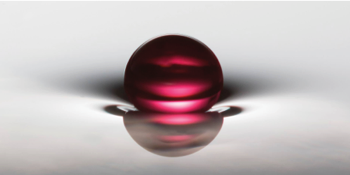Fluid Flows Help Levitate Liquids
Sprinkle water into a hot pan and, instead of boiling away immediately, the drops of liquid skim across the pan on protective cushions of water vapor. Studies of this phenomenon—called the Leidenfrost effect—have focused on drops levitating over solid substrates (see, for example, Synopsis: The Physics of Droplets Takes Off). Now, Benjamin Sobac, at the Université Libre de Bruxelles, Belgium, and colleagues show that for a liquid substrate, currents in the substrate reinforce levitation by enhancing heat flow to the substrate surface. And they find that these currents have opposite directions for different levitating liquids.
It has long been known that smooth surfaces can sustain the Leidenfrost effect at lower temperatures than rough ones. To test a surface that was molecularly smooth, Sobac and colleagues levitated drops of ethanol and HFE-7100 (an organic solvent) over a heated bath of silicone oil. Observing an unexpectedly efficient Leidenfrost effect (silicone oil is a poor conductor of heat), the researchers decided to investigate further.
Using particle image velocimetry, they saw a toroidal vortex ring form in the oil beneath both kinds of drops. With numerical simulations they uncovered the factors controlling the vortex’s dynamics. Vapor escaping from a drop's underside applied a shear force to the oil’s surface, inducing a flow that rose up at the center of the torus (directly beneath the drop) then moved radially away. This effect dominated beneath HFE-7100 drops. Meanwhile, cooling of the oil under a drop produced a descending plume of colder oil and a surface-tension gradient that opposed the force imparted by the escaping vapor. These effects dominated beneath ethanol drops. The researchers say that if they could alter these currents externally, they could control the motion of the levitating drop.
This research is published in Physical Review Fluids.
–Marric Stephens
Marric Stephens is a Corresponding Editor for Physics based in Bristol, UK.




